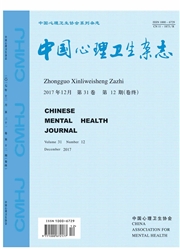

 中文摘要:
中文摘要:
目的:探讨精神科记忆门诊阿尔茨海默病(Alzheimer’SDisease,AD)患者精神行为症状特征及相关因素。方法:本研究样本来源于北京大学精神卫生研究所记忆中心2006年3月-2010年3月登记的数据库,共选取完成全套神经心理测查与精神行为评估的AD患者129例。采用神经精神科问卷(Neu-ropsychiatric Inventory,NPI)评定所有被试的精神行为症状。采用简易智力状态检查(Mini-MentalState Examination,MMSE)和阿尔茨海默病评定量表-认知部分(Alzheimer Disease Assessment Scale-CognitivePortion,ADAS-Cog)评定认知功能,日常生活活动能力量表(Activities of Daily Living,ADL)评定生活功能状况。依据MMSE评分将被试分为轻度(MMSEt〉20,46例)、中度(MMSE=11~19,59例)和重度(MMSE≤10,24例)3组。采用因子分析了解AD患者精神行为症状特征,采用方差分析比较3组间差异。结果:①对AD患者精神行为症状因子分析,得到3个症状群,分别为精神病性症状、额叶释放症状和情感症状。重度AD组NPI总分、精神病性症状因子分和额叶释放症状因子分显著高于轻、中度AD组(均P〈0.05)。轻、中、重度AD组间情感症状因子分差异无统计学意义(P〉0.05)。②AD患者精神行为症状相关因素:NH精神病性症状因子、额叶释放症状因子评分与ADAS~Cog记忆、语言、操作能力和注意力等因子分及ADL评分与呈正相关(r=0.28~0.47,P〈0.05),NPI情感症状因子分与ADAS-Cog语言和操作能力因子分呈正相关(r=0.19,0.24;P〈0.05)。结论:阿尔茨海默病患者精神行为症状以精神病性、额叶损害和情感症状为主要特征,随疾病严重程度加重而加重。认知和日常生活功能差的阿尔茨海默病患者的精神行为症状更严重。
 英文摘要:
英文摘要:
Objective: To investigate the characteristics and related factors of neuropsychiatric symptoms (NPS) in Alzheimer's disease (AD). Methods: Totally 129 AD patients who had completed the neuropsychological and neurobehavioral assessments were included in this analysis. NPS were assessed with the Neuropsychiatric Inventory (NPI). The cognitive function was assessed with the Mini-Mental State Examination (MMSE) and Alzlaeimer Disease Assessment Scale-Cognitive portion (ADAS-Cog). The functional status was assessed with the Aetivilies of Daily Living (ADL). According to the M/VISE score, AD patients were classified into mild (MMSE≥20, n =46), moderate (MMSE = 11~ 19, n =59), and severe (MMSE≤10, n = 24) cases. Factor analysis was used to examine the features of NPS in AD, and ANOVA was used for group comparisons. Results: (1) Factor analysis identified three symptom clusters in AD patients, including psychosis, frontal dysfunction and mood syndrome. The total scores and the sub-scores of psychosis and frontal dysfunction of NPI were higher in severe AD group than in mild and moderate AD groups ( e. g., the scores of psychotic syndrome, (21.4 ± 13.4) vs. ( 10. 5 ± 7. 9), ( 14. 0±10. 1 ), Ps 〈0. 05). The scores of mood syndrome was not significantly different among the three AD groups (Ps 〉0. 05). (2) There were significant positive correlation between the factor scores of psychosis, frontal dysfunction syndrome of NPI with the factor scores of memory, language, praxia, attention of ADAS-Cog as well as with ADL score ( r = 0. 28 ~0. 47, P 〈0. 05). The factor score of mood syndrome of NPI were positively correlated with the factor scores of language and praxis of ADAS-Cog (r =0. 19, 0. 24, Ps 〈0. 05). Conclusion: The neuropsychiawic symptoms in Alzheimer's disease may be characterized by psychosis, frontal dysfunction and mood syndrome. The frequency and severity of neuropsychiatric symptoms can increase with the severi
 同期刊论文项目
同期刊论文项目
 同项目期刊论文
同项目期刊论文
 Microstructural White Matter Abnormalities Independent of White Matter Lesion Burden in Amnestic Mil
Microstructural White Matter Abnormalities Independent of White Matter Lesion Burden in Amnestic Mil Regional quantification of white matter hyperintensity in normal aging, mild cognitive impairment, a
Regional quantification of white matter hyperintensity in normal aging, mild cognitive impairment, a Regional pattern of increased water diffusivity in hippocampus and corpus callosum in mild cognitive
Regional pattern of increased water diffusivity in hippocampus and corpus callosum in mild cognitive Alterations in Regional Brain Volume and Individual MRI-Guided Perfusion in Normal Control, Stable M
Alterations in Regional Brain Volume and Individual MRI-Guided Perfusion in Normal Control, Stable M 期刊信息
期刊信息
